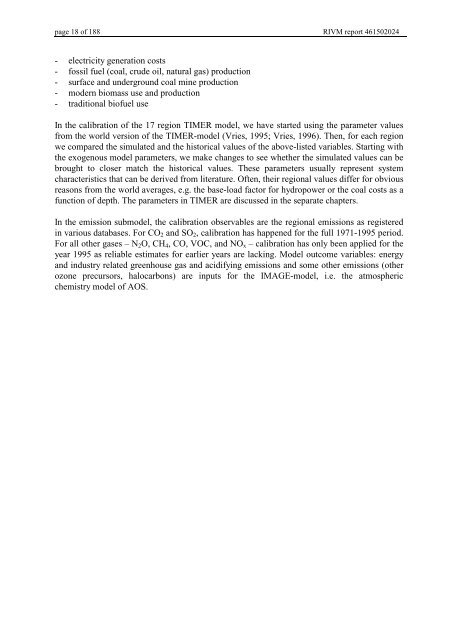Targets IMage Energy Regional (TIMER) Model, Technical ...
Targets IMage Energy Regional (TIMER) Model, Technical ...
Targets IMage Energy Regional (TIMER) Model, Technical ...
You also want an ePaper? Increase the reach of your titles
YUMPU automatically turns print PDFs into web optimized ePapers that Google loves.
page 18 of 188 RIVM report 461502024<br />
- electricity generation costs<br />
- fossil fuel (coal, crude oil, natural gas) production<br />
- surface and underground coal mine production<br />
- modern biomass use and production<br />
- traditional biofuel use<br />
In the calibration of the 17 region <strong>TIMER</strong> model, we have started using the parameter values<br />
from the world version of the <strong>TIMER</strong>-model (Vries, 1995; Vries, 1996). Then, for each region<br />
we compared the simulated and the historical values of the above-listed variables. Starting with<br />
the exogenous model parameters, we make changes to see whether the simulated values can be<br />
brought to closer match the historical values. These parameters usually represent system<br />
characteristics that can be derived from literature. Often, their regional values differ for obvious<br />
reasons from the world averages, e.g. the base-load factor for hydropower or the coal costs as a<br />
function of depth. The parameters in <strong>TIMER</strong> are discussed in the separate chapters.<br />
In the emission submodel, the calibration observables are the regional emissions as registered<br />
in various databases. For CO 2 and SO 2 , calibration has happened for the full 1971-1995 period.<br />
For all other gases – N 2 O, CH 4 , CO, VOC, and NO x – calibration has only been applied for the<br />
year 1995 as reliable estimates for earlier years are lacking. <strong>Model</strong> outcome variables: energy<br />
and industry related greenhouse gas and acidifying emissions and some other emissions (other<br />
ozone precursors, halocarbons) are inputs for the IMAGE-model, i.e. the atmospheric<br />
chemistry model of AOS.
















